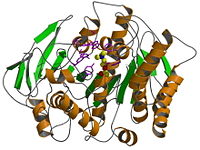ACETYLCHOLINESTERASE (E.C. 3.1.1.7) FROM TORPEDO CALIFORNICA
(see also AChE inhibitors and substrates)
Publication Abstract from PubMed
(-)-Huperzine A (HupA) is found in an extract from a club moss that has been used for centuries in Chinese folk medicine. Its action has been attributed to its ability to strongly inhibit acetylcholinesterase (AChE). The crystal structure of the complex of AChE with optically pure HupA at 2.5 A resolution shows an unexpected orientation for the inhibitor with surprisingly few strong direct interactions with protein residues to explain its high affinity. This structure is compared to the native structure of AChE devoid of any inhibitor as determined to the same resolution. An analysis of the affinities of structural analogues of HupA, correlated with their interactions with the protein, shows the importance of individual hydrophobic interactions between HupA and aromatic residues in the active-site gorge of AChE.
Structure of acetylcholinesterase complexed with the nootropic alkaloid, (-)-huperzine A., Raves ML, Harel M, Pang YP, Silman I, Kozikowski AP, Sussman JL, Nat Struct Biol. 1997 Jan;4(1):57-63. PMID:8989325
From MEDLINE®/PubMed®, a database of the U.S. National Library of Medicine.
Overview
Solution of the three-dimensional (3D) structure
of Torpedo californica acetylcholinesterase (TcAChE)
in 1991 (Sussman et al. & Silman (1991)) opened up new horizons in research on an enzyme that had already been the subject of intensive investigation. The unanticipated structure of this extremely rapid enzyme, in which the active site was found to be buried at the bottom of a , lined by (colored darkmagenta), led to a revision of the views then held concerning substrate traffic, recognition, and hydrolysis (Botti et al. Sussman & Silman (1999)). This led to a series of theoretical and experimental studies, which took advantage of recent advances in theoretical techniques for treatment of proteins, such as
molecular dynamics and electrostatics and to site-directed mutagenesis, utilizing suitable expression
systems. Acetylcholinesterase hydrolysizes the neurotransmitter acetylcholine , producing group. ACh directly binds (via its nucleophilic Oγ atom) within the . The residues are also important in the ligand recognition. After this binding acetylcholinesterase ACh.
About this Structure
2ACE is a Single protein structure of sequence from Torpedo californica with ACH as ligand. This structure superseeds the now removed PDB entry 1ACE. Active as Acetylcholinesterase, with EC number 3.1.1.7 Structure known Active Site: CAT. Full crystallographic information is available from OCA.
Additional Resources
For additional information, see: Alzheimer's Disease

